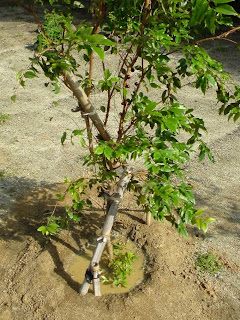I was very impressed by the flavour of the Jaboticaba fruit I tasted at the garden shop the other day, and after checking that the tree is supposedly cold tolerant down to -6°C , I bought it (in Matsuyama, the average temperature gets down to 1.9°C in February). When it arrived, I gobbled down a few of the fruit to get the energy to plant the tree, and decided that the fruit is a delicious cross between a cherry and a grape, but with much more reliable sweetness.
The Jaboticaba is said to like a deep soil with a lot of organic content, so I dug a hole about half a metre deep and filled it with compost and charcoal. Digging the hole in the solid clay/quartz mix was a major undertaking which took nearly an hour. It seems miraculous that the roots of plants can penetrate this medium when a pick axe can only penetrate a couple of inches with a good hard swing.
 This hole goes a long way down, and is full of Terra Preta goodness
This hole goes a long way down, and is full of Terra Preta goodnessI'm saving the seeds of the Jaboticaba fruit and I'll try planting them. I believe that the cultivar I have is probably "Sabara" which is said to be "precocious". I hope so, because waiting 8 to 10 years for a seedling to fruit would really try my patience.
The almond tree has given up its single fruit. In the rains of the last few months, it gradually took on a very disreputable appearance, and today when I poked it cautiously with a gloved finger, it fell off the bush and some little poisonous ants came streaming out of it.
The almond tree has given up its single fruit. In the rains of the last few months, it gradually took on a very disreputable appearance, and today when I poked it cautiously with a gloved finger, it fell off the bush and some little poisonous ants came streaming out of it.
 Inside the half-rotten "fruit" portion, the pit seemed to be in reasonable condition. Presumably, when this is cracked open, there should be a pristine almond inside. Whereas in California and other dry places like that, the fruit is left to dessicate and fall off on its own, in Japan where fruiting coincides with wet weather, the husbandman is supposed to devise measures for drying the fruit before it rots. Next year, I can see myself either hoping for a dry snap (but only in relation to the almonds!) or leaving matters to the ants, since no harm seems to have been done this year.
Inside the half-rotten "fruit" portion, the pit seemed to be in reasonable condition. Presumably, when this is cracked open, there should be a pristine almond inside. Whereas in California and other dry places like that, the fruit is left to dessicate and fall off on its own, in Japan where fruiting coincides with wet weather, the husbandman is supposed to devise measures for drying the fruit before it rots. Next year, I can see myself either hoping for a dry snap (but only in relation to the almonds!) or leaving matters to the ants, since no harm seems to have been done this year.










